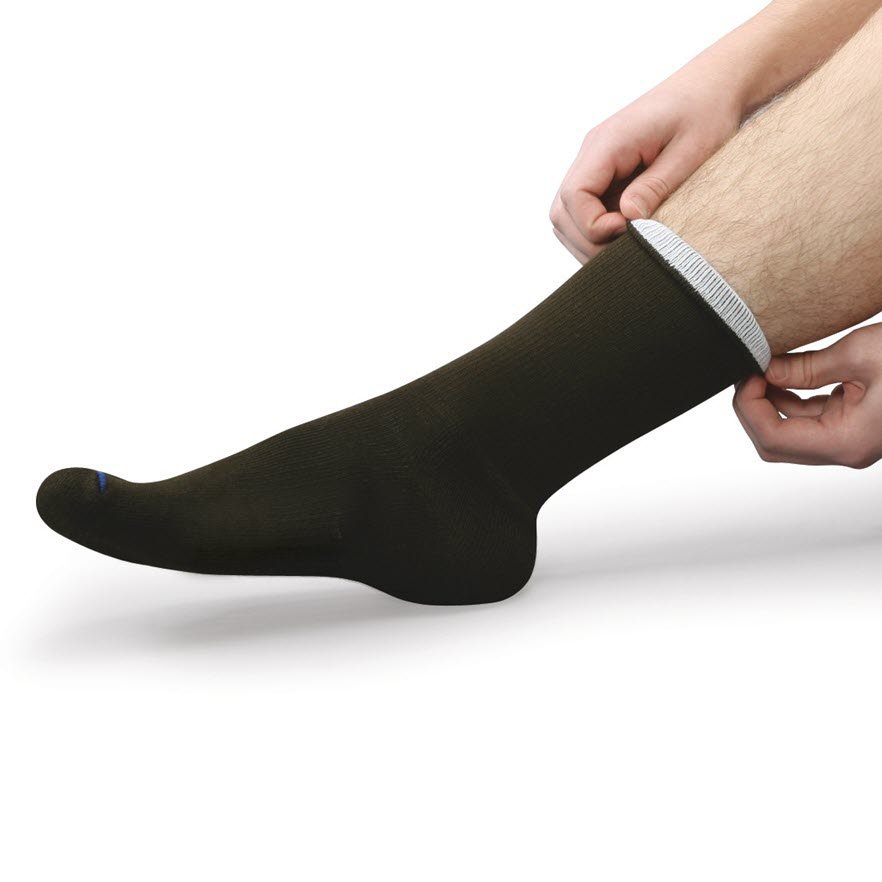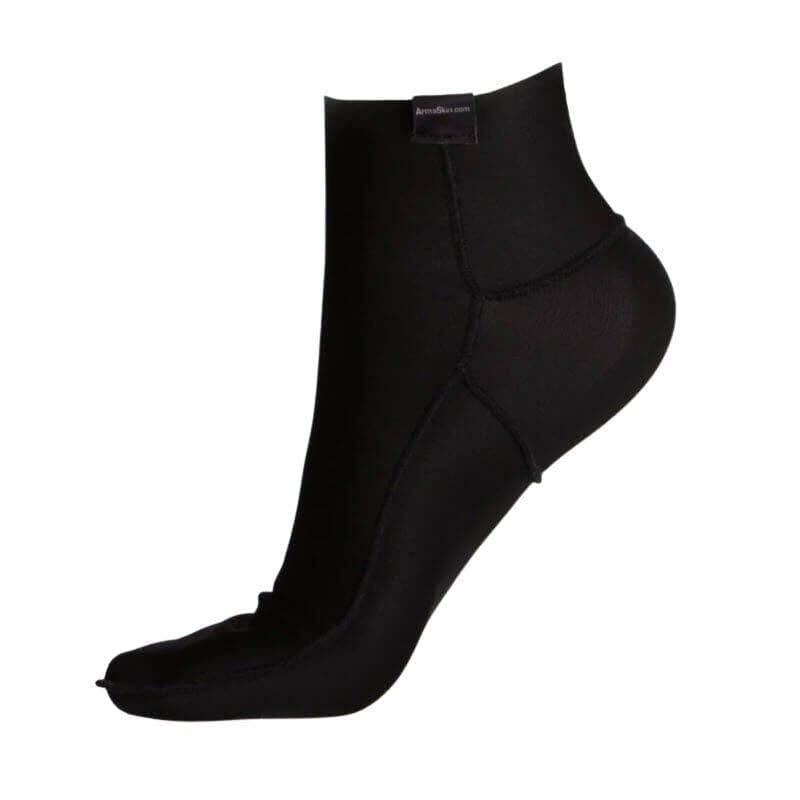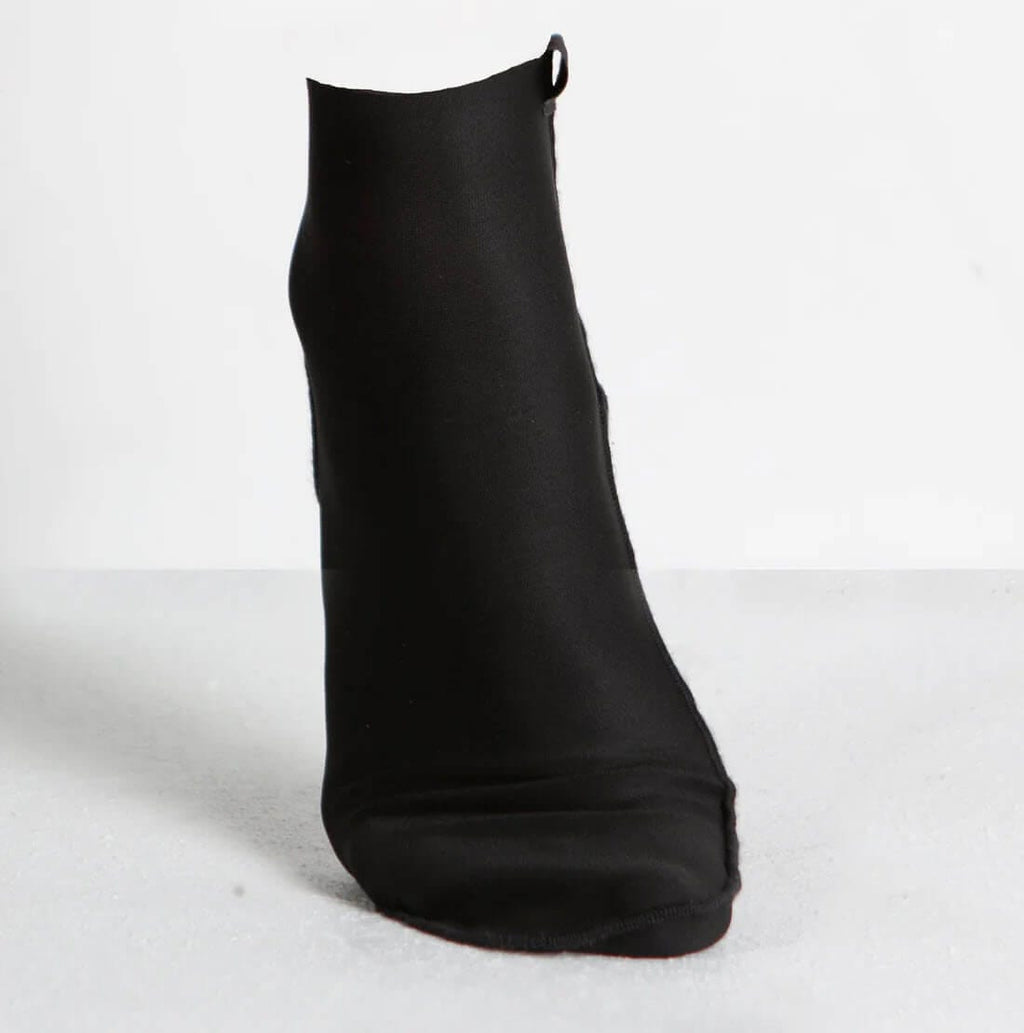No doubt you've heard of double socks or double-layer socks. In this article, we’ll answer:
- Who uses double socks
- What they are exactly
- Where you get them from
- Why they work
There are 2 types of double sock systems
- Literally wearing 2 pairs of socks
- Socks that have two layers at certain locations within the sock (double-layer socks)
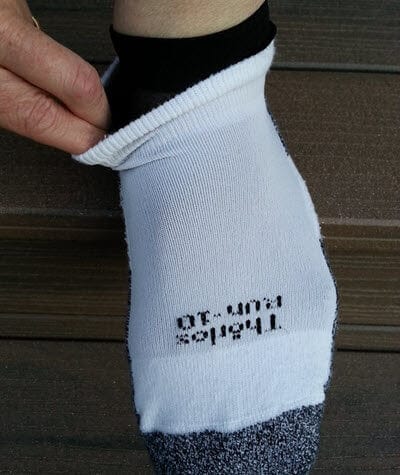
Double socks: Wearing two different socks, one over the other
To understand how double socks work, you need to know about material interfaces
An interface is where two surfaces meet. When wearing shoes & socks there are two interfaces:
- Skin-sock interface (black line)
- Sock-shoe interface (blue line)
Each interface has a certain level of friction. This measurement is called the coefficient of friction (COF) which is a number usually less than 1.0. In the shoe, friction levels generally range from 0.40 - 0.90 (Carlson, 2009). When blisters are a problem, there is high friction at both of the interfaces. One way to prevent blisters is to reduce the COF at one of these interfaces. Examples would be
- Lubricants, powders, antiperspirants: at the skin-sock interface (black line)
- ENGO Blister Patches: at the shoe-sock interface (blue line)
- friction interfaces within the shoe
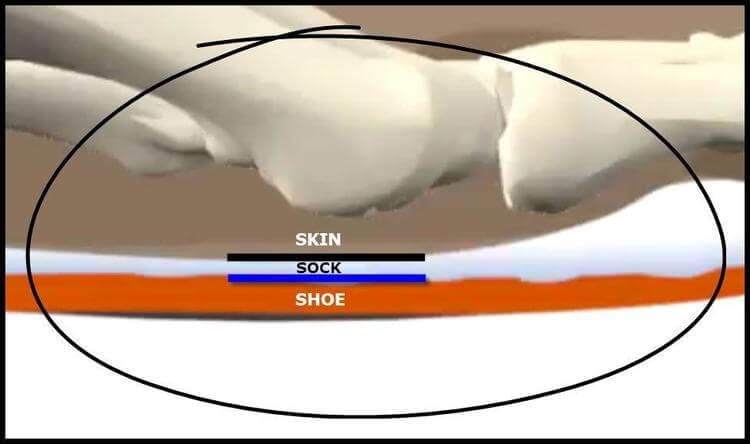
There are two material interfaces when wearing a single pair of socks (skin/sock and sock/shoe)
Double-socks introduce a third interface
You can create an extra interface by wearing another pair of socks. This creates a sock-sock interface. If the sock-sock interface COF is lower than that of the other two interfaces, the two socks will slide across one another before the others are able to. That will reduce the magnitude of blister-causing shear distortions.
Double sock research
Wearing two pairs of socks has been shown to somewhat reduce blister incidence in a military population when compared to the standard-issue military sock (Knapik et al, 1996). The following two results are quoted from Richie (1997):
Study 1 (1992)
In a study of 357 marine recruits on Parris Island, South Carolina in 1992, the use of a CoolMax® liner with a heavily padded terry design outer sock using a wool/polypropylene blend significantly reduced blisters compared to a single layer sock (40% vs. 69%). Adding a CoolMax® liner to the standard sock significantly reduced sick call visits (24.4% standard vs. 9.4% standard with liner).
Study 2 (1993)
Another study of 1,079 soldiers in 1993 tested five sock systems on blister frequency and acceptability by soldiers. Synthetic fiber socks significantly outperformed the standard wool sock. Adding a CoolMax® liner to the wool sock significantly reduced blisters. When comparing single, extra-thick acrylic padded socks to double layer sock-systems, the double-layer system was superior owing to the shielding of the open terry loops from the skin surface and the movement interface created by the double-layer system.
In spite of these favourable research results, there is little information available about specific successful two-sock combinations. It's likely that individuals are experimenting with their own combinations in a trial and error approach. My understanding is the ideal sock combination is a close-fitting thin hydrophobic (water-repelling) inner sock, with a thicker hydrophilic (water absorbant) or moisture-wicking outer sock that maintains its bulk in spite of moisture. This sets up a moisture-wicking function as well as serving as a third interface. Richie's outstanding discussion on fibre properties states the descending order of sock fibre hydrophillic ranking is:
Cotton - Wool - Acrylic - CoolMax® - Polypropylene
Three commercially available double socks (and my own experiences)
WrightSock:
WrightSock make socks with two layers built in to them. Every time I put them on, the inner sock tends to fold over on itself in a couple of places, enough to think that it's going to cause a problem. But that doesn't last long and has never been an issue while I'm walking or running. My foot seems to move around too much in the beginning as the two layers easily glide over one another. But again, this doesn't last long - presumably a bit of sweat increases friction levels enough to lessen the relative movement. The ones I've used have the fibre content below.
- Lightweight: InnerLayer (70% Polyester 30% Nylon); OuterLayer (68% Polyester 28% Nylon 4% Lycra)
- Midweight: InnerLayer (70% Polyester 26% Nylon 4% Lycra); OuterLayer (68% Polyester 24% Nylon 8% Lycra)
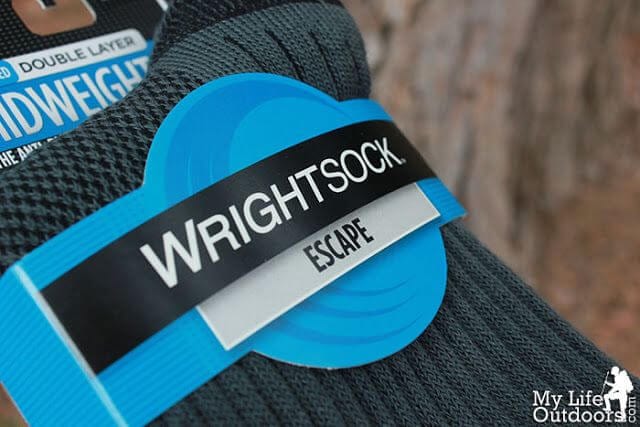 WrightSocks double socks (image credit: mylifeoutdoors.com)
WrightSocks double socks (image credit: mylifeoutdoors.com)
Fortisocks (no longer in production):
A one size fits all thin short tubular sock designed to be the inner sock layer. Although they no longer sell these, you get the same effect with a pair of ladies nylon knee-high stockings cut shorter and worn under your standard sock.
ArmaSkin:
Also an inner sock layer, the ArmaSkin sock is different to other double sock inners I've seen. They feel very unusual because the sock sticks to you. I'm sure that's because of the silicone content - silicone has a high friction level. Their fibre content is 87% polyester 16% Spandex 5% silicone.You don't pull these on like normal socks - they don't slide against the skin. You need to "roll" them on. Although I got the smallest size (Ladies 2-8) they were a bit big and the heel doesn't contour exactly right. It didn't really both me though. And the big bulky seams surprisingly didn't bother me (except the one under my heel that ordinarily wouldn't have been there if you had the right sized foot).
I am left wondering how the silicone inner side deals with sweat. I've heard of variable levels of satisfaction from runners and bushwalkers. Ultra168 had a few readers trial them to get feedback - worth a read. As did The Bushwalking Blog here.
Knowing what I know about interfaces, ArmaSkin socks work by creating an artificially high skin-sock friction level, so the sock grips to the skin, all but guaranteeing the sock-sock friction level is lower. The manufacturers are yet to test the friction properties of the ArmaSkin sock (no sock manufacturer has to my knowledge). I’d love to know as I’m sure these have a really low friction level. And I'm pretty sure ArmaSkin socks do the best job at reducing friction levels and preventing blisters compared to the others.
Double Socks or Not Really?
I have heard of socks being referred to as double socks but which in my opinion aren't. They consist of different materials on the inner compared to the outer side of the sock, most likely serving a moisture-wicking function as decsribed earlier. However, the layers are not separated. Here's a discussion about it amongst bushwalkers. The way double socks work is by having the two sock layers moving relative to each other so they must be separate layers.
Toe-socks such as Injinji can be thought of as a form of double sock system for interdigital areas and may theoretically reduce the incidence of interdigital blisters. That is assuming the COF remains sufficiently low. This sock-sock interface is actually the same material, whereas the principal of double sock systems is to use the effect of different sock materials or construction for friction reducing properties. However, blister incidence may be reduced as a result of the increased bulk between the toes acting as cushioning to reduce pressure peaks.
Who's wearing double socks?
My informal conversations with blister-sufferers and athletic / adventure footwear retailers indicates it is a method used more by hikers than it is runners and other athletes. Double-socking is talked about a lot on various forums as the concept is well known. I’m not sure it is used widely though, but it’s hard to tell for sure. There are many that do double-sock and get the blister prevention results they need. Others presumably don't an move on to something else.
A final thought
Assuming a double sock system reduces friction significantly, it does so all over the foot. This global approach to friction management is not without its potential problems. My own thought is, assuming vigorous or long-lasting exercise, this effect will soon be over-ridden due to perspiration such that higher friction exists at this interface. At that point, whether the friction level remains low enough to maintain blister-free low-friction conditions will depend on the individual. Armaskin are your best bet. But if you continue to get blisters, an additional strategy will be required.
